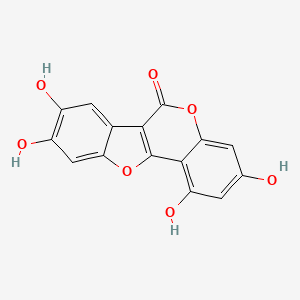
|
Demethylwedelolactone |
Demethylwedelolactone is a lipid of Polyketides (PK) class. |
12 |
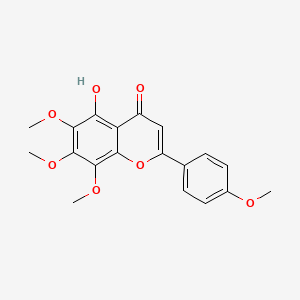
|
Gardenin B |
Gardenin B is a lipid of Polyketides (PK) class. |
12 |
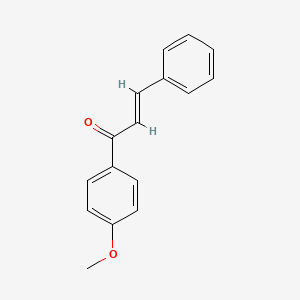
|
4'-Methoxychalcone |
4'-Methoxychalcone is a lipid of Polyketides (PK) class. |
15 |

|
2R-hydroxy-oleic acid |
2r-hydroxy-oleic acid is a lipid of Fatty Acyls (FA) class. |
17 |
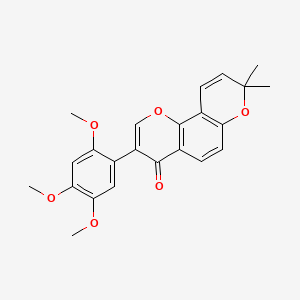
|
Barbigerone |
Barbigerone is a lipid of Polyketides (PK) class. |
17 |
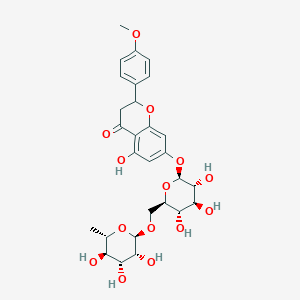
|
MEGxp0_001204 |
MEGxp0_001204 is a lipid of Polyketides (PK) class. |
19 |
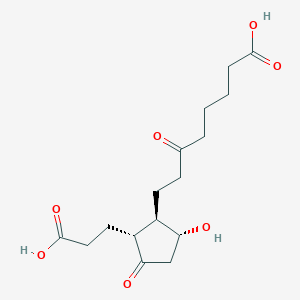
|
Tetranor-pgem |
Tetranor-pgem is a lipid of Fatty Acyls (FA) class. |
25 |
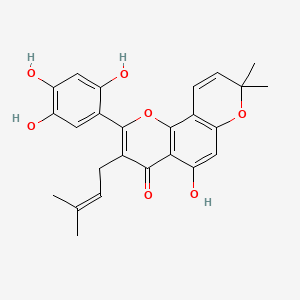
|
Artonin E |
Artonin E is a lipid of Polyketides (PK) class. |
27 |

|
9-hydroxystearic acid |
9-hydroxystearic acid is a lipid of Fatty Acyls (FA) class. |
31 |
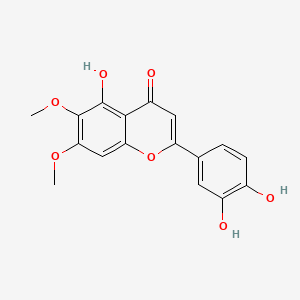
|
Cirsiliol |
Cirsiliol is a lipid of Polyketides (PK) class. |
31 |
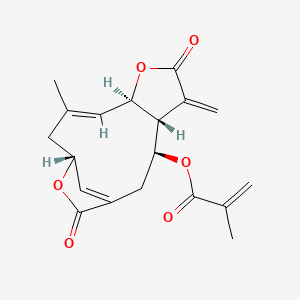
|
Deoxyelephantopin |
Deoxyelephantopin is a lipid of Prenol Lipids (PR) class. |
38 |
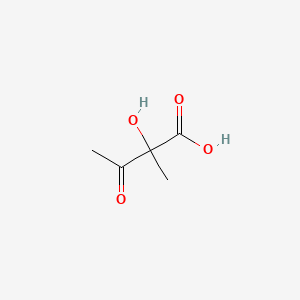
|
2-acetolactate |
2-acetolactate is a lipid of Fatty Acyls (FA) class. |
46 |

|
(-)-alpha-cedrene |
(-)-alpha-cedrene is a lipid of Prenol Lipids (PR) class. |
46 |

|
Alpinumisoflavone |
Alpinumisoflavone is a lipid of Polyketides (PK) class. The involved functions are known as inhibitors, Metabolic Inhibition, Hypoxia, Diastasis and Chemotaxis. |
47 |

|
Tectochrysin |
Tectochrysin is a lipid of Polyketides (PK) class. The involved functions are known as Prenylation, Cell Growth, adenosinetriphosphatase activity, Drug Efflux and Mutation. The associated genes with Tectochrysin are CD9 gene and ABCB1 gene. |
62 |
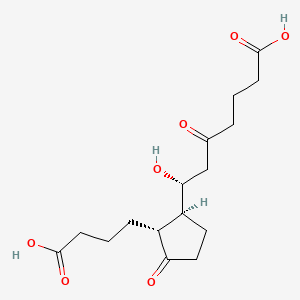
|
Prostaglandin M |
Prostaglandin m is a lipid of Fatty Acyls (FA) class. |
69 |
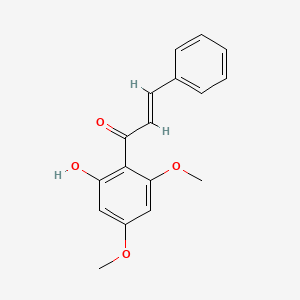
|
Flavokawain b |
Flavokawain b is a lipid of Polyketides (PK) class. Flavokawain b is associated with abnormalities such as Helminthiasis. The involved functions are known as Cell Death and MAPK Signaling Pathway. Flavokawain b often locates in Blood, Entire bony skeleton and Integumentary system. |
74 |
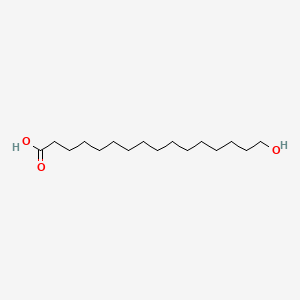
|
Juniperic acid |
Juniperic acid is a lipid of Fatty Acyls (FA) class. |
79 |
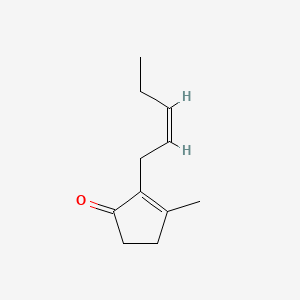
|
cis-Jasmone |
Cis-jasmone is a lipid of Fatty Acyls (FA) class. Cis-jasmone is associated with abnormalities such as Plague and Brucella infections. The involved functions are known as Drug Interactions. |
82 |
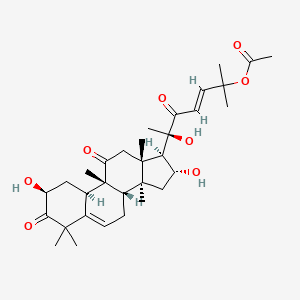
|
Cucurbitacin B |
Cucurbitacin b is a lipid of Sterol Lipids (ST) class. Cucurbitacin b is associated with abnormalities such as Morphologically altered structure. The involved functions are known as Signal Transduction, Apoptosis, Cell Cycle Arrest, Cell Cycle and Negative Regulation of Mitosis. Cucurbitacin b often locates in Mediastinum and Pseudopodia. The associated genes with Cucurbitacin B are STAT5A gene, JAK2 gene, STAT3 gene, CDKN1A gene and BCL2L1 gene. The related experimental models are Xenograft Model. |
89 |

|
Rhamnetin |
Rhamnetin is a lipid of Polyketides (PK) class. Rhamnetin is associated with abnormalities such as Neurodegenerative Disorders. The involved functions are known as Process, Gene Expression, Chemotaxis, Regulation and Cell Mobility. Rhamnetin often locates in Cell surface. |
115 |
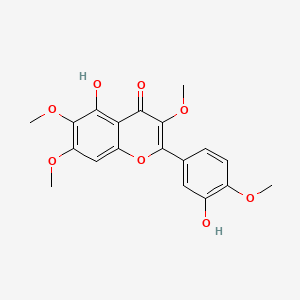
|
Casticin |
Casticin is a lipid of Polyketides (PK) class. The involved functions are known as Ligand Binding. The related lipids are linoleates. |
122 |
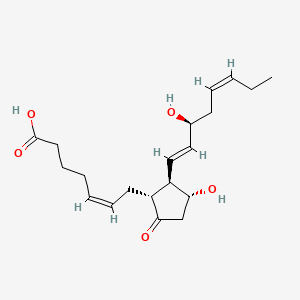
|
PGE3 |
Pge3 is a lipid of Fatty Acyls (FA) class. |
125 |

|
(2e,4e)-deca-2,4-dienal |
(2e,4e)-deca-2,4-dienal is a lipid of Fatty Acyls (FA) class. |
125 |
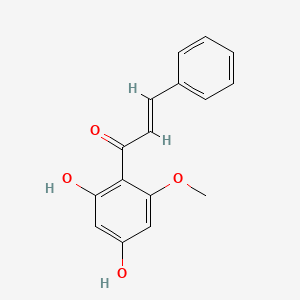
|
Cardamonin |
Cardamonin is a lipid of Polyketides (PK) class. Cardamonin is associated with abnormalities such as Septicemia, endothelial dysfunction, Hypertensive disease, Morphologically altered structure and Disintegration. The involved functions are known as Phosphorylation, Transcriptional Activation, Cell secretion, Canonical Wnt Signaling Pathway and Signal Transduction. Cardamonin often locates in Extracellular, Body tissue, IkappaB kinase complex, Membrane and Muscle, Smooth, Vascular. The associated genes with Cardamonin are ITLN1 gene, Candidate Disease Gene, MTPN gene, Genes, Reporter and PTGS2 gene. The related lipids are Lipopolysaccharides. |
128 |
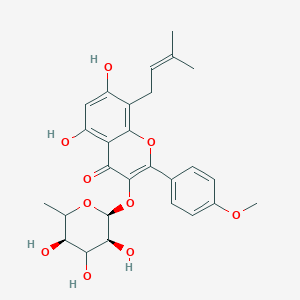
|
Baohuoside 1 |
Baohuoside 1 is a lipid of Polyketides (PK) class. |
130 |
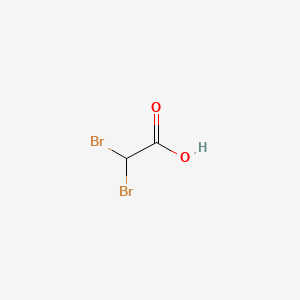
|
2,2-dibromoacetic acid |
2,2-dibromoacetic acid is a lipid of Fatty Acyls (FA) class. |
137 |

|
Epothilone A |
Epothilone a is a lipid of Polyketides (PK) class. Epothilone a is associated with abnormalities such as abnormal fragmented structure and Hyperostosis, Diffuse Idiopathic Skeletal. The involved functions are known as Polymerization, Mutation, Depolymerization, Musculoskeletal torsion, function and Negative Regulation of Microtubule Depolymerization. Epothilone a often locates in Microtubules, soluble, Nuclear Structure and Microtubule cytoskeleton. The associated genes with Epothilone A are C9 gene, SLC33A1 gene, KIF2C gene and HMHA1 gene. |
160 |
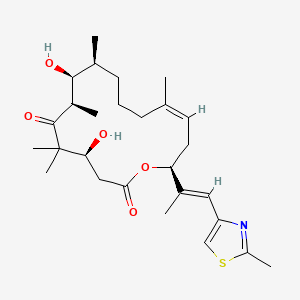
|
Epothilone D |
Epothilone d is a lipid of Polyketides (PK) class. Epothilone d is associated with abnormalities such as Tauopathies, Neutropenia, Neuropathy and Hematological Disease. The involved functions are known as Mutation, Apoptosis, Mitotic arrest, Cell Growth and Anabolism. Epothilone d often locates in Cytoskeleton, Axon, Cell Wall, Chromosomes and Spindle. The associated genes with epothilone D are SLC33A1 gene, Chromatin, GTF2I gene and HEXA gene. |
174 |
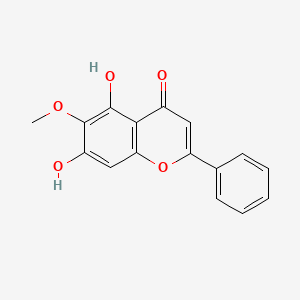
|
Oroxylin A |
Oroxylin A is a lipid of Polyketides (PK) class. |
180 |
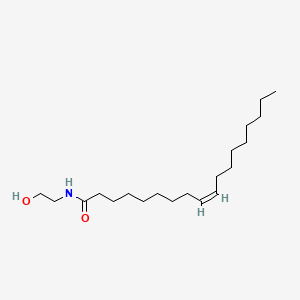
|
N-oleoyl ethanolamine |
N-oleoyl ethanolamine is a lipid of Fatty Acyls (FA) class. |
190 |

|
butein |
Butein is a lipid of Polyketides (PK) class. Butein is associated with abnormalities such as Glomerulonephritis, Fibrosis, Liver, Kidney Failure, Acute, Mastocytosis and Chimera disorder. The involved functions are known as Phosphorylation, Transcription, Genetic, IkappaB kinase activity, Gene Expression and Signal Transduction. Butein often locates in Membrane, Cytoplasmic, IkappaB kinase complex, Protoplasm and Plasma membrane. The associated genes with Butein are ICAM1 gene, MAPK8 gene, MYC gene, BCL2 gene and BCL2L1 gene. The related lipids are Promega. The related experimental models are Xenograft Model, Knock-out and Mouse Model. |
190 |

|
ponasterone A |
Ponasterone a is a lipid of Sterol Lipids (ST) class. Ponasterone a is associated with abnormalities such as Hyperostosis, Diffuse Idiopathic Skeletal and Infection. The involved functions are known as Apoptosis, Transcription, Genetic, Signal, Cell Death and DNA Binding. Ponasterone a often locates in Body tissue, Tissue membrane, Membrane, Protoplasm and Clone. The associated genes with ponasterone A are RUNX3 gene, FOXG1 gene, Candidate Disease Gene, TNFSF10 gene and GAPDH gene. The related lipids are muristerone. The related experimental models are Mouse Model. |
192 |
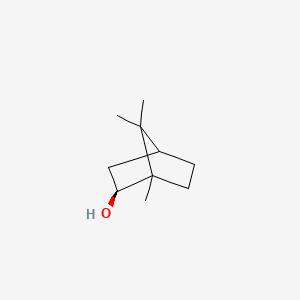
|
(+)-borneol |
(+)-borneol is a lipid of Prenol Lipids (PR) class. |
211 |
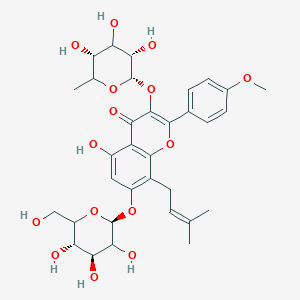
|
LMPK12112009 |
LMPK12112009 is a lipid of Polyketides (PK) class. |
216 |
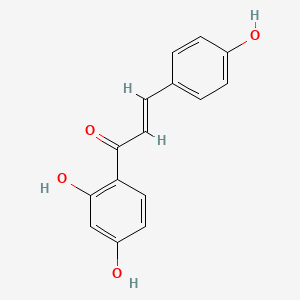
|
isoliquiritigenin |
Isoliquiritigenin is a lipid of Polyketides (PK) class. Isoliquiritigenin is associated with abnormalities such as abnormal fragmented structure, Gastric ulcer, Gastric mucosa lesion, Peptic Ulcer and Wiskott-Aldrich Syndrome. The involved functions are known as Mass-to-Charge Ratio, Anabolism, Oxidation, inhibitors and Energy Absorption. Isoliquiritigenin often locates in Microsomes, Liver, Hepatic, Microsomes, Immune system and Vacuole. The associated genes with Isoliquiritigenin are P4HTM gene, BCL2 gene, AP1AR gene, oxytocin, 1-desamino-(O-Et-Tyr)(2)- and ODAM gene. The related experimental models are Knock-out. |
220 |
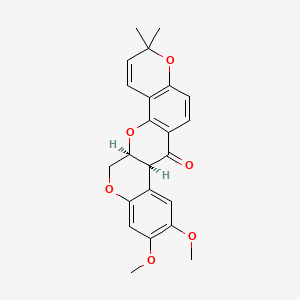
|
Deguelin |
Deguelin is a lipid of Polyketides (PK) class. Deguelin is associated with abnormalities such as Hypertensive disease, Parkinson Disease and athymia. The involved functions are known as inhibitors, Drug Interactions, ATP binding, Down-Regulation and Angiogenesis. Deguelin often locates in Endothelium, Vascular and Body tissue. The associated genes with Deguelin are MAP2K1 gene. |
246 |
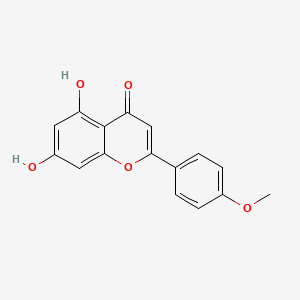
|
acacetin |
acacetin is a lipid of Polyketides (PK) class. Acacetin is associated with abnormalities such as Cardiovascular Diseases, Janiceps and Meralgia paresthetica. The involved functions are known as Cell Cycle Arrest, Cell Growth, Agent, Metabolic Inhibition and Cell Death. Acacetin often locates in Protoplasm, Membrane, Plasma membrane, Capillary blood and Endothelium. The associated genes with acacetin are CDKN1B gene, KCNH2 gene, MSMP gene, COX8A gene and PI3 gene. The related lipids are Lipopolysaccharides. The related experimental models are Xenograft Model. |
277 |

|
(-)-Perillyl alcohol |
(-)-perillyl alcohol is a lipid of Prenol Lipids (PR) class. The involved functions are known as Cell Cycle Progression, Cell Cycle, Cell Proliferation, Apoptosis and Isoprenylation. (-)-perillyl alcohol often locates in Cytoplasm, Membrane and Plasma membrane. The associated genes with (-)-Perillyl alcohol are JUN gene, Candidate Disease Gene, IL24 gene, BCL2L1 gene and CFB gene. The related experimental models are Transgenic Model. |
299 |

|
Tangeretin |
Tangeretin is a lipid of Polyketides (PK) class. Tangeretin is associated with abnormalities such as Cardiovascular Diseases, Complex Regional Pain Syndromes, Blood Clot, Hypercholesterolemia and Restenosis. The involved functions are known as Thrombus, Platelet function, Localized desquamation, Platelet Activation and Signal. Tangeretin often locates in Protoplasm, Cytoplasmic Granules, Cytoplasmic matrix, Plasma membrane and Blood. The associated genes with Tangeretin are GP6 gene, CDK2 gene, CDK6 gene, Tumor Suppressor Genes and CDH1 gene. The related lipids are Lipopolysaccharides. The related experimental models are Mouse Model and Transgenic Model. |
325 |

|
Crocetin |
Crocetin is a lipid of Prenol Lipids (PR) class. Crocetin is associated with abnormalities such as abnormal fragmented structure, Gout, Infection and athymia. The involved functions are known as Cytokinesis, Anabolism, enzyme mechanism, Pathological accumulation of air in tissues and Hemorrhage. Crocetin often locates in Vacuole, Cytoplasmic matrix, Body tissue, Mitochondria and Blood. The associated genes with Crocetin are cytochrome c'', BCL2 gene and PCNA gene. The related lipids are mycorradicin. |
350 |
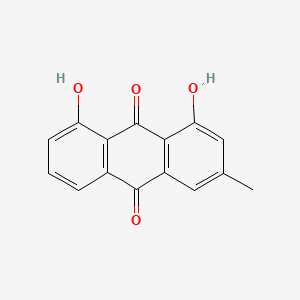
|
Chrysophanol |
Chrysophanol is a lipid of Polyketides (PK) class. Chrysophanol is associated with abnormalities such as Wiskott-Aldrich Syndrome. The involved functions are known as Diastasis and Analyte. |
351 |
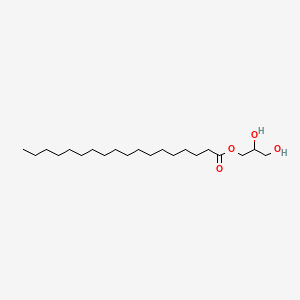
|
Glyceryl monostearate |
Glyceryl monostearate is a lipid of Glycerolipids (GL) class. |
353 |
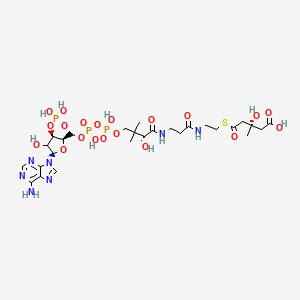
|
HMG-CoA |
Hmg-coa is a lipid of Fatty Acyls (FA) class. Hmg-coa is associated with abnormalities such as Cardiovascular Diseases, Hypercholesterolemia, Metabolic Diseases, Hyperhomocysteinemia and Morphologically altered structure. The involved functions are known as ketone body biosynthetic process, Regulation, Mutation, enzyme activity and HMG-CoA synthase activity. Hmg-coa often locates in Mitochondria, Cytoplasmic matrix, Hepatic, Membrane and Flank (surface region). The associated genes with HMG-CoA are Human gene, HMGCS2 gene, PPARA gene, ACSL1 Gene and Candidate Disease Gene. The related lipids are Fatty Acids, Sterols, Dehydrocholesterols, Lipopolysaccharides and 7-dehydrocholesterol. |
355 |
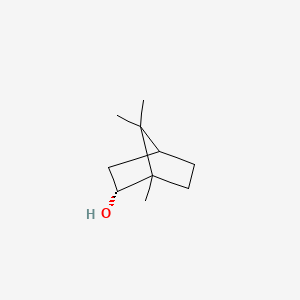
|
(-)-Borneol |
(-)-borneol is a lipid of Prenol Lipids (PR) class. The involved functions are known as Protein-Protein Interaction. |
355 |
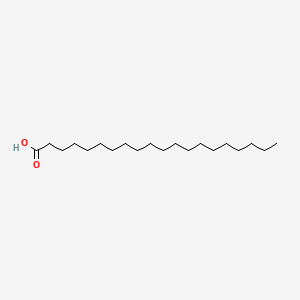
|
Arachidic acid |
Arachidic acid is a lipid of Fatty Acyls (FA) class. Arachidic acid is associated with abnormalities such as nervous system disorder, Liver diseases, Obesity, Diabetes Mellitus, Non-Insulin-Dependent and Cardiovascular Diseases. The involved functions are known as Process, Regulation, Saturated, Oxidation and enzyme activity. Arachidic acid often locates in Mitochondria, Brown Fat, Microsomes, Membrane and Muscle. The associated genes with Arachidic acid are ELOVL3 gene, P4HTM gene, CFLAR gene, Homologous Gene and Polypeptides. The related lipids are Fatty Acids, Glycerophospholipids, Palmitates, Stearic acid and hexadecenoic acid. |
356 |
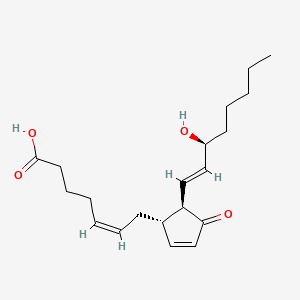
|
Prostaglandin j2 |
Prostaglandin j2 is a lipid of Fatty Acyls (FA) class. The involved functions are known as Apoptosis, inhibitors, Binding (Molecular Function), Protein Overexpression and Cell Proliferation. |
373 |
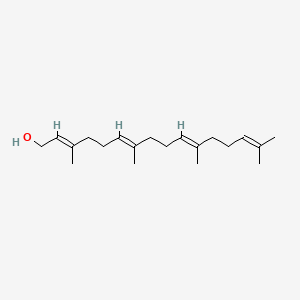
|
Geranylgeraniol |
Geranylgeraniol is a lipid of Prenol Lipids (PR) class. Geranylgeraniol is associated with abnormalities such as abnormal fragmented structure, Hyperostosis, Diffuse Idiopathic Skeletal and Tuberculosis. The involved functions are known as Positive Regulation of Apoptosis, Anabolism, Prenylation, Apoptosis and pathologic cytolysis. Geranylgeraniol often locates in Body tissue, Cytoplasmic matrix, Red Cell Ghost, Spindle and Nuclear lamin. The associated genes with Geranylgeraniol are MST1 gene, STN gene, UMOD gene, ABCA1 gene and RHOA gene. The related lipids are Sterols, Hydroxycholesterols, SK&F 104976 and 25-hydroxycholesterol. |
403 |
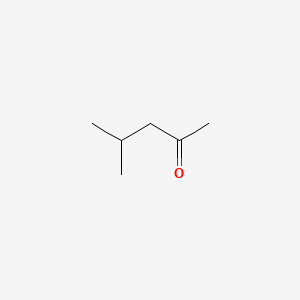
|
4-methyl-2-pentanone |
4-methyl-2-pentanone is a lipid of Fatty Acyls (FA) class. |
437 |
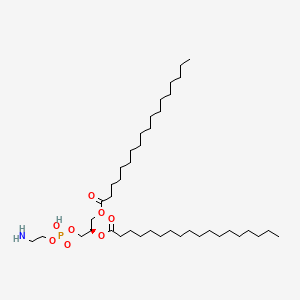
|
1,2-Distearoyl-sn-glycero-3-phosphoethanolamine |
1,2-Distearoyl-sn-glycero-3-phosphoethanolamine is a lipid of Glycerophospholipids (GP) class. 1,2-distearoyl-sn-glycero-3-phosphoethanolamine is associated with abnormalities such as Painful Bladder Syndrome, Dehydration, Renal tubular disorder, Gigantism and Tumor-Associated Vasculature. The involved functions are known as conjugation, Ligand Binding, Process, Laser-generated electromagnetic radiation and Blood Circulation. 1,2-distearoyl-sn-glycero-3-phosphoethanolamine often locates in Tissue membrane, Early endosome, Body tissue, Cell surface and Membrane. The associated genes with 1,2-Distearoyl-sn-glycero-3-phosphoethanolamine are R peptide, P4HTM gene, NHS gene, TSPO gene and SLC33A1 gene. The related lipids are Liposomes, 1,2-distearoylphosphatidylethanolamine, Micelles, Fatty Acids and sialogangliosides. |
438 |
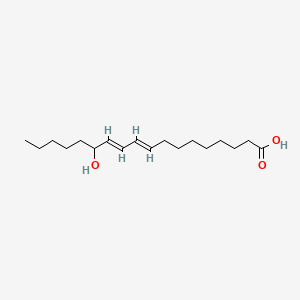
|
alpha-artemisic acid |
Alpha-artemisic acid is a lipid of Fatty Acyls (FA) class. |
448 |
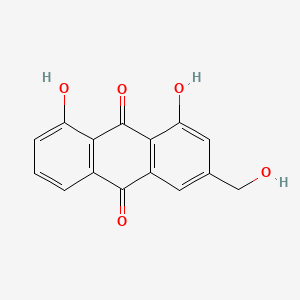
|
Aloe-emodin |
Aloe-emodin is a lipid of Polyketides (PK) class. Aloe-emodin is associated with abnormalities such as Wiskott-Aldrich Syndrome. The involved functions are known as Anabolism, Phosphorylation, Signal Transduction, Cell Proliferation and Cell Survival. Aloe-emodin often locates in Body tissue, Cell Fraction, Mitochondria, Micronucleus and Microsomes, Liver. The associated genes with Aloe-emodin are MECHANISTIC TARGET OF RAPAMYCIN COMPLEX 2, RICTOR gene, PI3 gene, PRR5 gene and MANEA gene. |
451 |
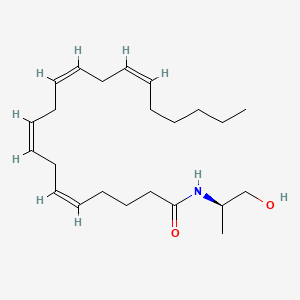
|
N-(1R-methyl-2-hydroxy-ethyl) arachidonoyl amine |
N-(1r-methyl-2-hydroxy-ethyl) arachidonoyl amine is a lipid of Fatty Acyls (FA) class. |
457 |
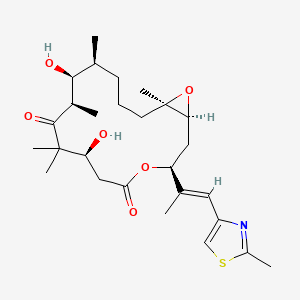
|
Epothilone B |
Epothilone B is a lipid of Polyketides (PK) class. Epothilone b is associated with abnormalities such as Myelosuppression, Measurable Disease, Neuropathy, Neutropenia and Thrombocytopenia. The involved functions are known as Cell Cycle Arrest, Apoptosis, Signal Transduction, Cytokinesis and Caspase Activation. Epothilone b often locates in Mitochondria, Cytoplasmic matrix, Microtubules, Spindle and Protoplasm. The associated genes with Epothilone B are TNFSF10 gene, DIABLO gene, FADD gene, BCL2 gene and BCL2L1 gene. The related lipids are Promega and Phosphatidylserines. The related experimental models are Xenograft Model and Mouse Model. |
492 |

|
pentan-2-one |
Pentan-2-one is a lipid of Fatty Acyls (FA) class. The related lipids are Butyrates. |
535 |
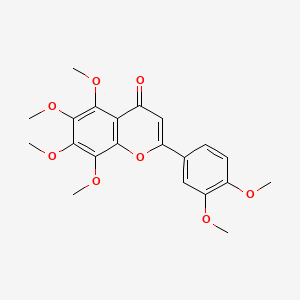
|
Nobiletin |
Nobiletin is a lipid of Polyketides (PK) class. Nobiletin is associated with abnormalities such as Hashimoto Disease, nervous system disorder, Dermatitis, Senile Plaques and Metabolic Diseases. The involved functions are known as 5-(carboxyamino)imidazole ribonucleotide mutase activity, Signal Transduction, Biochemical Pathway, Phosphorylation and MAP kinase kinase activity. Nobiletin often locates in Extracellular, Protoplasm, Back, Mouse Skin and Skin - Epidermis (MMHCC). The associated genes with Nobiletin are MAP2K1 gene, PTGS2 gene, Amyloid beta-Protein Precursor, Candidate Disease Gene and BCL2 gene. The related lipids are Lipopolysaccharides and Sterols. The related experimental models are Mouse Model and Transgenic Model. |
550 |
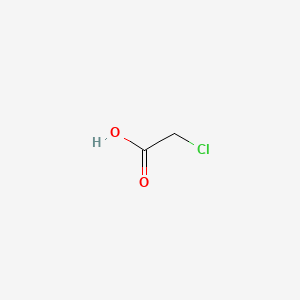
|
2-chloro-acetic acid |
2-chloro-acetic acid is a lipid of Fatty Acyls (FA) class. |
574 |
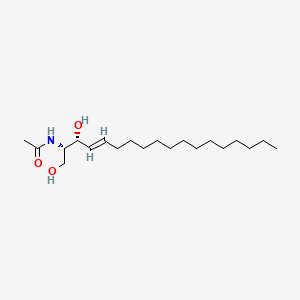
|
N-acetylsphingosine |
N-acetylsphingosine is a lipid of Sphingolipids (SP) class. N-acetylsphingosine is associated with abnormalities such as Morphologically altered structure, Atherosclerosis, Cardiovascular Diseases, Hyperinsulinism and Gigantism. The involved functions are known as inhibitors, anti-apoptosis, Apoptosis, Dephosphorylation and immunoreactivity. N-acetylsphingosine often locates in Plasma membrane, Mitochondria, Pore, Membrane and Cytoplasmic matrix. The associated genes with N-acetylsphingosine are EGR3 gene, CFB gene, FATE1 gene, P4HTM gene and PFDN4 gene. The related lipids are Sphingolipids, Cardiolipins, Glycerophospholipids, dihydroceramide and Phosphatidic Acid. |
633 |

|
(-)-Epicatechin gallate |
(-)-Epicatechin gallate is a lipid of Polyketides (PK) class. (-)-epicatechin gallate is associated with abnormalities such as Infection, trachomatis, Heart Diseases, Influenza and Hypoglycemia. The involved functions are known as Cell Proliferation, Metabolic Inhibition, Anabolism, protein expression and Apoptosis. (-)-epicatechin gallate often locates in Tissue membrane, Membrane, soluble, Plasma membrane and Protoplasm. The associated genes with (-)-Epicatechin gallate are GDF15 gene, ATF3 gene, CRISP2 gene, Homologous Gene and activating transcription factor 3. The related lipids are Lipopolysaccharides. The related experimental models are Cancer Model and Mouse Model. |
645 |
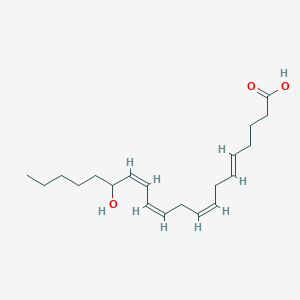
|
15-hete |
15-hete is a lipid of Fatty Acyls (FA) class. The involved functions are known as Inflammation, Signal Transduction, inhibitors, Obstruction and Adjudication. 15-hete often locates in Endothelium, Protoplasm, Cytoplasm, Cytoplasmic and Extracellular. |
725 |
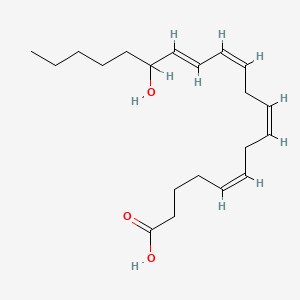
|
15-hete |
15-hete is a lipid of Fatty Acyls (FA) class. 15-hete is associated with abnormalities such as Endothelial dysfunction, Atherosclerosis, Risk factor, cardiovascular, hypercholesterolemia and Diabetes. The involved functions are known as uptake, Inflammation, Phosphorylation, Oxidation and Atherogenesis. 15-hete often locates in Endothelium, Cell surface, Protoplasm, Body tissue and Blood. The associated genes with 15-hete are CD36 gene, CCL2 gene, Orthologous Gene, SMAD2 gene and SMAD3 gene. The related lipids are 9-hydroxy-10,12-octadecadienoic acid and hydroxy fatty acid. |
725 |
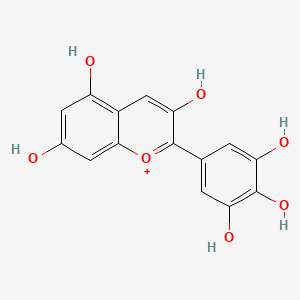
|
Delphinidin |
Delphinidin is a lipid of Polyketides (PK) class. Delphinidin is associated with abnormalities such as Virus Diseases, Chronic disease, Inflammatory disorder, Degenerative polyarthritis and Cardiovascular Diseases. The involved functions are known as Signal Pathways, Metabolic Inhibition, Signal Transduction, Cell Proliferation and Cell Death. Delphinidin often locates in Tissue membrane, Tubulo-reticular structure, Smooth muscle (tissue), Endothelium and soluble. The associated genes with Delphinidin are KDR gene, P4HTM gene, IRAK1 gene, MAPK14 wt Allele and ADAMTS3 gene. The related lipids are Steroids, Total cholesterol and saikosaponin B2. The related experimental models are Xenograft Model, Knock-out, Disease model and Animal Disease Models. |
727 |

|
Wogonin |
Wogonin is a lipid of Polyketides (PK) class. Wogonin is associated with abnormalities such as Hyperlipidemia, Atherosclerosis, Inflammatory disorder, Dermatitis, Atopic and Ischemia. The involved functions are known as Inflammation, Regulation, luciferase activity, store-operated calcium entry and Transcriptional Activation. Wogonin often locates in Cytoplasmic matrix, Pore, Membrane, Protoplasm and Mitochondria. The associated genes with Wogonin are SGK1 gene, ORAI1 gene, STIM1 gene, P4HTM gene and BCL2 gene. |
732 |
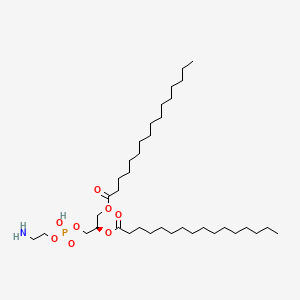
|
923-61-5 |
923-61-5 is a lipid of Glycerophospholipids (GP) class. 923-61-5 is associated with abnormalities such as Gigantism, Hyperostosis of skull, BOSLEY-SALIH-ALORAINY SYNDROME, Anemia, Sickle Cell and Amyloidosis. The involved functions are known as Protein Binding, Anabolism, Signal Transduction, Detergents and Genetic Translation Process. 923-61-5 often locates in soluble, Tissue membrane, brush border membrane, Mouse Kidney and Plasma membrane. The associated genes with 923-61-5 are THEMIS gene, SLC33A1 gene, P4HTM gene, Integral Membrane Proteins and Protein Structure. The related lipids are 1,2-oleoylphosphatidylcholine, Unilamellar Vesicles, Membrane Lipids, DOPE and Micelles. |
755 |
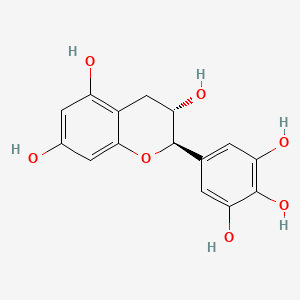
|
Gallocatechin |
(+)-gallocatechin is a lipid of Polyketides (PK) class. The involved functions are known as inhibitors and Cell Survival. The associated genes with (+)-Gallocatechin are TERT gene. |
778 |
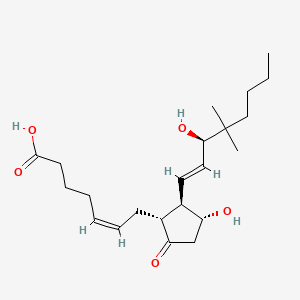
|
16,16-dimethyl-PGE2 |
16,16-dimethyl-pge2 is a lipid of Fatty Acyls (FA) class. |
785 |
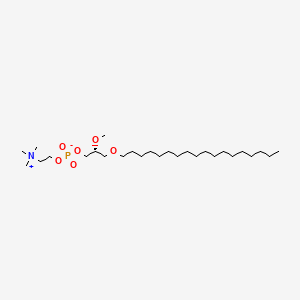
|
ET-18-OCH3 |
ET-18-OCH3 is a lipid of Glycerophospholipids (GP) class. Et-18-och3 is associated with abnormalities such as Morphologically altered structure, Choline Deficiency, Acquired partial lipodystrophy and Punctate inner choroidopathy. The involved functions are known as Mutation, establishment and maintenance of localization, Uptake, Increased Sensitivy and Process. Et-18-och3 often locates in Plasma membrane, Membrane, Back, Protoplasm and Endoplasmic Reticulum. The associated genes with ET-18-OCH3 are Genome, Alleles, ATP8A1 gene, Homologous Gene and ATPase Gene. The related lipids are Phosphatidylserines, Sphingolipids, Lysophosphatidylcholines, Phospholipid Ethers and Phosphatidate. The related experimental models are Knock-out. |
794 |

|
lysophosphatidic acid |
lysophosphatidic acid is a lipid of Glycerophospholipids (GP) class. Lysophosphatidic acid is associated with abnormalities such as Atherosclerosis, Alzheimer's Disease, Asthma, Diabetes Mellitus, Non-Insulin-Dependent and Septicemia. The involved functions are known as Inflammation, Chemotaxis, Binding (Molecular Function), Polymerization and Inflammatory Response. Lysophosphatidic acid often locates in Cytoskeleton, Microfilaments, actin cytoskeleton, Extracellular and Structure of germinal center of lymph node. The associated genes with lysophosphatidic acid are TNF gene, MAPK3 gene, RHOA gene, CDC42 gene and ADRBK1 gene. The related lipids are lysophosphatidic acid, Lipopolysaccharides, Lysophosphatidylcholines, Lysophospholipids and Phosphatidic Acid. The related experimental models are Knock-out, Transgenic Model, Rodent Model and Disease model. |
820 |
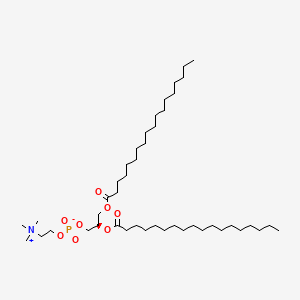
|
816-94-4 |
816-94-4 is a lipid of Glycerophospholipids (GP) class. 816-94-4 is associated with abnormalities such as Gigantism, Pulmonary Hypertension, Neutropenia, Serum Sickness and Urticaria. The involved functions are known as pulmonary effects, Hemodynamics, Stereochemistry, Host defense and Blood Circulation. 816-94-4 often locates in vesicle, Blood, biological membrane, soluble and Cardiopulmonary. The associated genes with 816-94-4 are pentaglobulin, EMILIN1 gene and FASTK Gene. The related lipids are Liposomes, dimyristoylphosphatidylglycerol, Lipopolysaccharides, Unilamellar Liposomes and Unilamellar Vesicles. |
828 |
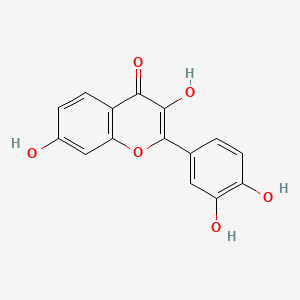
|
Fisetin |
Fisetin is a lipid of Polyketides (PK) class. Fisetin is associated with abnormalities such as Morphologically altered structure, PARKINSON DISEASE, LATE-ONSET, Tetanus, CNS disorder and Disintegration (morphologic abnormality). The involved functions are known as Autophagy, Apoptosis, Energy Metabolism, Acceleration and Anabolism. Fisetin often locates in Mitochondria, Cytoplasmic matrix, Extracellular, Cytoskeletal Filaments and Autophagic vacuole. The associated genes with Fisetin are SIRT1 gene, MAP1LC3A gene, TP53 gene, P4HTM gene and AURKB gene. The related lipids are Phosphatidylserines and Lipopolysaccharides. The related experimental models are Animal Cancer Model, Xenograft Model, Mouse Model, Cancer Model and Disease model. |
832 |

|
Megestrol acetate |
Megestrol acetate is a lipid of Sterol Lipids (ST) class. Megestrol acetate is associated with abnormalities such as Anorexia, Malnutrition, HIV Infections, Thrombocytopenia and Exanthema. The involved functions are known as Bleeding of vagina, Agent, Cell Survival, Cytopenia and Regulation. The associated genes with Megestrol acetate are Genome. The related lipids are Steroids. The related experimental models are Xenograft Model. |
866 |
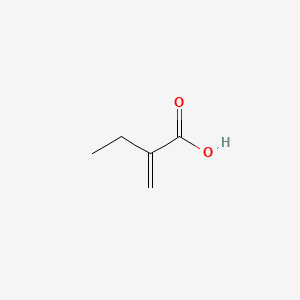
|
2-Ethylacrylic acid |
2-Ethylacrylic acid is a lipid of Fatty Acyls (FA) class. The involved functions are known as hemolysis. |
869 |
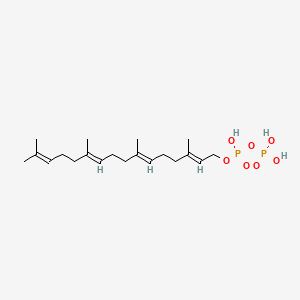
|
Geranylgeranyl diphosphate |
Geranylgeranyl diphosphate is a lipid of Prenol Lipids (PR) class. The involved functions are known as RNA Interference, Anabolism, Cytokinesis, Gene Expression and physiological aspects. Geranylgeranyl diphosphate often locates in soluble, Skeletal system, Cell-Free System, Plasma membrane and soluble fraction. The associated genes with Geranylgeranyl diphosphate are Genome, IMPACT gene, Open Reading Frames, Gene Clusters and Genes, Regulator. The related lipids are Fatty Acids, Sterols, terpentetriene and Membrane Lipids. |
885 |
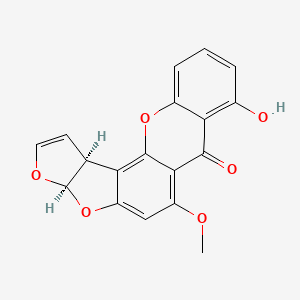
|
STERIGMATOCYSTIN |
STERIGMATOCYSTIN is a lipid of Polyketides (PK) class. Sterigmatocystin is associated with abnormalities such as CLEFT LIP, CONGENITAL HEALED, Exanthema and Lung diseases. The involved functions are known as sterigmatocystin biosynthetic process, Signal, secondary metabolic process, Biosynthetic Pathways and Anabolism. Sterigmatocystin often locates in Genital system, SAGA complex, Chromosomes, germ tube and Extracellular. The associated genes with STERIGMATOCYSTIN are Genome, Genes, vif, Homologous Gene, Genes, Regulator and Gene Clusters. The related lipids are hexanoic acid, Fatty Acids and Fatty Acids, Unsaturated. |
891 |
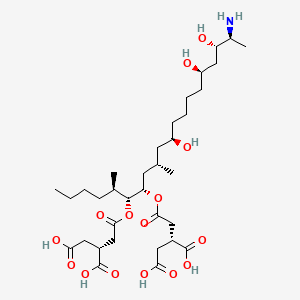
|
fumonisin b1 |
fumonisin b1 is a lipid of Sphingolipids (SP) class. Fumonisin b1 is associated with abnormalities such as Infection, Kidney Diseases, Liver diseases, DERMATITIS HERPETIFORMIS, FAMILIAL and Malnutrition. The involved functions are known as Gene Expression, Anabolism, Signal, Biosynthetic Pathways and Regulation. Fumonisin b1 often locates in Body tissue, Microsomes, microsomal membrane, Protoplasm and Mitochondria. The associated genes with fumonisin b1 are Genome, P4HTM gene, FATE1 gene, BCL2 gene and TMEM132D gene. The related lipids are dihydroceramide, ceramide 1-phosphate, Sphingolipids, Fatty Acids and Palmitates. |
902 |
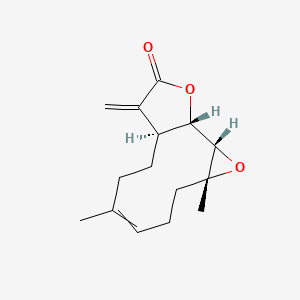
|
Parthenolide |
Parthenolide is a lipid of Prenol Lipids (PR) class. Parthenolide is associated with abnormalities such as Migraine Disorders, abnormal fragmented structure, Hyperostosis, Diffuse Idiopathic Skeletal, Consumption-archaic term for TB and Infection. The involved functions are known as Apoptosis, Cell Proliferation, Inflammation, pathologic cytolysis and Membrane Potentials. Parthenolide often locates in Mitochondria, Tissue membrane, Cytoplasmic matrix, Cytoplasm and Body tissue. The associated genes with Parthenolide are IGKJ1 gene, BCL2 gene, DDIT3 gene, Procaspase 7 and GAPDH gene. The related lipids are A(2)C. The related experimental models are Mouse Model, Xenograft Model, Breast Cancer Model and Cancer Model. |
925 |
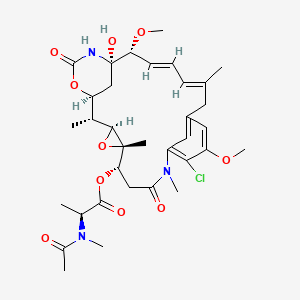
|
MAYTANSINE |
MAYTANSINE is a lipid of Polyketides (PK) class. Maytansine is associated with abnormalities such as Myelosuppression and BOSLEY-SALIH-ALORAINY SYNDROME. The involved functions are known as Mutation, Agent, Polymerization, Cell Cycle Arrest and Drug Kinetics. Maytansine often locates in Cytoplasm, Hepatic, Lysosomes, Cell surface and Microtubules. The associated genes with MAYTANSINE are ABCB1 gene, HM13 gene, CNN1 gene, CYP2C8 gene and CYP2D6 gene. The related lipids are Valerates. The related experimental models are Xenograft Model. |
984 |
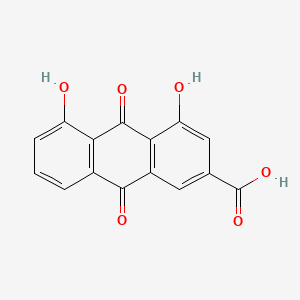
|
Rhein |
Rhein is a lipid of Polyketides (PK) class. Rhein is associated with abnormalities such as Obesity, Non-alcoholic Fatty Liver Disease, Dyslipidemias, Fatty Liver and Degenerative polyarthritis. The involved functions are known as Adipogenesis, Insulin Resistance, luciferase activity, Transcription, Genetic and Inflammation. Rhein often locates in Hepatic, Brown Fat, Muscle, Mouse Liver and Mitochondria. The associated genes with Rhein are QRSL1 gene, Candidate Disease Gene, CFB gene, STAT6 gene and GATA3 gene. The related lipids are Fatty Acids. |
986 |
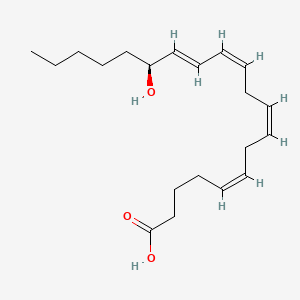
|
15S-HETE |
15s-hete is a lipid of Fatty Acyls (FA) class. 15s-hete is associated with abnormalities such as Ischemia and Vascular Diseases. The involved functions are known as Transcription, Genetic, Signal Transduction, tube formation, Angiogenic Process and Biochemical Pathway. 15s-hete often locates in Endothelium, Membrane, Cytoplasm, Body tissue and Protoplasm. The associated genes with 15S-HETE are RAC1 gene, ALOX15 gene, ALOX5 gene, Candidate Disease Gene and GAPDH gene. |
1011 |
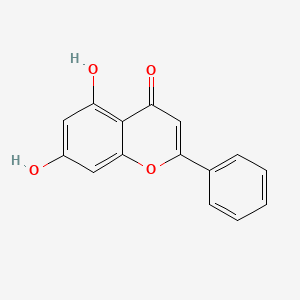
|
chrysin |
chrysin is a lipid of Polyketides (PK) class. Chrysin is associated with abnormalities such as Unconjugated hyperbilirubinemia, Metabolic Diseases, Hypogonadism, Renal tubular disorder and Colitis. The involved functions are known as Hypoxia, enzyme activity, Oxidation, inhibitors and Cell Survival. Chrysin often locates in Protoplasm, Plasma membrane, Back, Extracellular and Mitochondria. The associated genes with chrysin are CFB gene, P4HTM gene, UGT1A9 gene, CYP1A1 gene and UGT1A1 gene. The related lipids are Promega, estradiol-3-glucuronide, Steroids and Lipopolysaccharides. The related experimental models are Mouse Model. |
1085 |
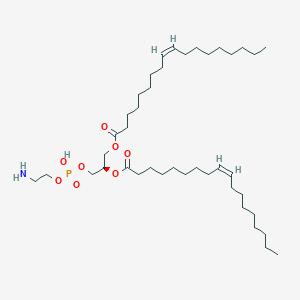
|
PE(18:1(9Z)/18:1(9Z)) |
PE(18:1(9Z)/18:1(9Z)) is a lipid of Glycerophospholipids (GP) class. Pe(18:1(9z)/18:1(9z)) is associated with abnormalities such as Respiratory Failure, Myopathy, Muscular Dystrophy, Duchenne, Autoimmune Lymphoproliferative Syndrome and Osteoporosis. The involved functions are known as establishment and maintenance of localization, Anabolism, Protein Biosynthesis, nuclear mRNA cis splicing, via spliceosome and Increased Sensitivy. Pe(18:1(9z)/18:1(9z)) often locates in Sarcolemma, Muscle, Membrane, viral nucleocapsid location and Tissue fiber. The associated genes with PE(18:1(9Z)/18:1(9Z)) are DMD gene, DUOXA1 gene, P4HTM gene, delta sleep-inducing peptide, N-Tyr- and Homologous Gene. The related lipids are Lipofectin, Liposomes, Pregnadienes, N-(1-(2,3-dioleyloxy)propyl)-N,N,N-trimethylammonium chloride and DOPE. |
1117 |
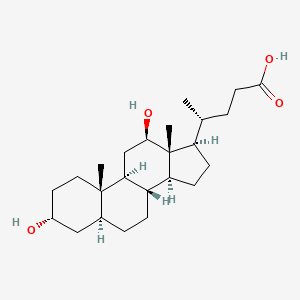
|
3alpha,12beta-dihydroxy-5alpha-cholan-24-oic acid |
3alpha,12beta-dihydroxy-5alpha-cholan-24-oic acid is a lipid of Sterol Lipids (ST) class. 3alpha,12beta-dihydroxy-5alpha-cholan-24-oic acid is associated with abnormalities such as Cholestasis and Little's Disease. The involved functions are known as inhibitors, Signal Transduction, Phosphorylation, Cell Survival and Detergents. 3alpha,12beta-dihydroxy-5alpha-cholan-24-oic acid often locates in Protoplasm. The related lipids are Promega. |
1175 |
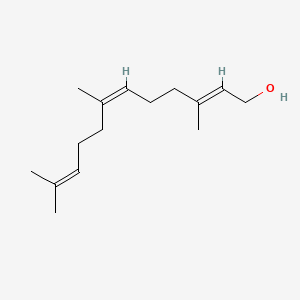
|
(e,z)-farnesol |
(e,z)-farnesol is a lipid of Prenol Lipids (PR) class. |
1183 |
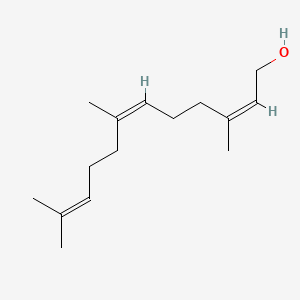
|
(z,z)-farnesol |
(z,z)-farnesol is a lipid of Prenol Lipids (PR) class. |
1183 |
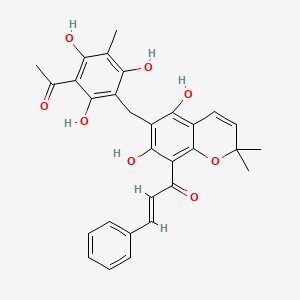
|
rottlerin |
Rottlerin is a lipid of Polyketides (PK) class. Rottlerin is associated with abnormalities such as PARAGANGLIOMAS 2, Hyperostosis, Diffuse Idiopathic Skeletal, Virus Diseases, Perisylvian syndrome and Autoimmune disease (systemic) NOS. The involved functions are known as Apoptosis, Regulation, Signal Transduction, inhibitors and Proteasome Inhibitors [MoA]. Rottlerin often locates in Clone, Membrane, Body tissue, Plasma membrane and soluble. The associated genes with Rottlerin are XIAP gene, GAPDH gene, ICAM1 gene, P4HTM gene and TNFSF10 gene. The related lipids are Promega, Fatty Acids, Sphingolipids, Lipopolysaccharides and Saponin. The related experimental models are Mouse Model, Xenograft Model and Cancer Model. |
1198 |
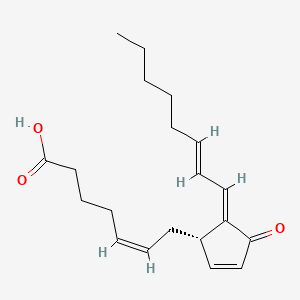
|
15-deoxy-delta-12,14-PGJ2 |
15-deoxy-delta-12,14-pgj2 is a lipid of Fatty Acyls (FA) class. 15-deoxy-delta-12,14-pgj2 is associated with abnormalities such as Dehydration and Myocardial Ischemia. The involved functions are known as Binding (Molecular Function), Inflammation, Alveolar ventilation function, Stimulus and Process. 15-deoxy-delta-12,14-pgj2 often locates in Cytosol, Myocardial tissue and Heart tissue. The associated genes with 15-deoxy-delta-12,14-PGJ2 are Homologous Gene and G-substrate. The related lipids are 15-deoxyprostaglandin J2 and Lipopolysaccharides. |
1201 |
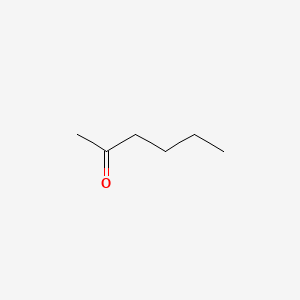
|
2-hexanone |
2-hexanone is a lipid of Fatty Acyls (FA) class. 2-hexanone is associated with abnormalities such as Virus Diseases, Egg drop syndrome, Senile Plaques, Chronic Obstructive Airway Disease and COPD exacerbation. The involved functions are known as Permissiveness, Biological Function, Synthesis, Tropism, Amplification and Cellular Tropism. 2-hexanone often locates in Vertex, viral capsid, Tissue fiber, Cell surface and host. The associated genes with 2-hexanone are Polylysine, Fusion Protein, Genome, Lac Gene and chimeric gene. The related lipids are Promega, Lipopolysaccharides, oligofectamine, Propionate and FuGene. The related experimental models are Transgenic Model, Xenograft Model and Rodent Model. |
1204 |

|
(-)-Epigallocatechin |
(-)-Epigallocatechin is a lipid of Polyketides (PK) class. The involved functions are known as Protective Agents, inhibitors, Process, Drug Kinetics and Fermentation. (-)-epigallocatechin often locates in Hepatic, Blood, Membrane, Back and apical membrane. The associated genes with (-)-Epigallocatechin are ADRBK1 gene and FASTK Gene. The related lipids are 1,2-dilinolenoyl-3-(4-aminobutyryl)propane-1,2,3-triol. The related experimental models are Rodent Model and Transgenic Model. |
1282 |
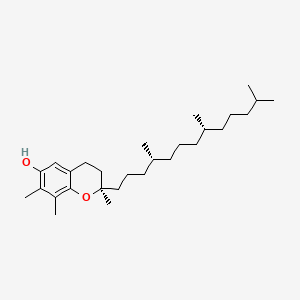
|
gamma-tocopherol |
Gamma-tocopherol is a lipid of Prenol Lipids (PR) class. The involved functions are known as 5-(carboxyamino)imidazole ribonucleotide mutase activity, Adverse effects, Longterm Effects, Luteal Phase and Drug Interactions. Gamma-tocopherol often locates in Blood. The related lipids are Total cholesterol. |
1377 |

|
hesperidin |
(2S)-5-hydroxy-2-(3-hydroxy-4-methoxyphenyl)-4-oxo-3,4-dihydro-2H-chromen-7-yl 6-O-(6-deoxyhexopyranosyl)hexopyranoside is a lipid of Polyketides (PK) class. (2s)-5-hydroxy-2-(3-hydroxy-4-methoxyphenyl)-4-oxo-3,4-dihydro-2h-chromen-7-yl 6-o-(6-deoxyhexopyranosyl)hexopyranoside is associated with abnormalities such as Osteoporosis, Postmenopausal, estrogen deficiency, Chronic venous insufficiency, Neurodegenerative Disorders and Cerebrovascular accident. The involved functions are known as Sweetening Agents, Vmax, enzyme activity, Fermentation and Regulation. (2s)-5-hydroxy-2-(3-hydroxy-4-methoxyphenyl)-4-oxo-3,4-dihydro-2h-chromen-7-yl 6-o-(6-deoxyhexopyranosyl)hexopyranoside often locates in Entire gastrointestinal tract, soluble, Entire bony skeleton, Trabecular substance of bone and Blood. The associated genes with (2S)-5-hydroxy-2-(3-hydroxy-4-methoxyphenyl)-4-oxo-3,4-dihydro-2H-chromen-7-yl 6-O-(6-deoxyhexopyranosyl)hexopyranoside are MTPN gene, GLUCOSIDASE, STN gene, SLC33A1 gene and GHRL gene. The related lipids are Total cholesterol and blood lipid. The related experimental models are Arthritis, Collagen-Induced. |
1455 |
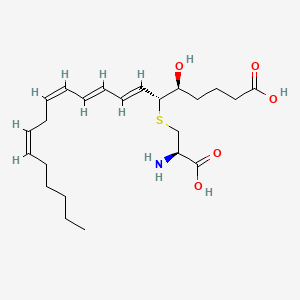
|
LTE4 |
Lte4 is a lipid of Fatty Acyls (FA) class. Lte4 is associated with abnormalities such as Asthma, Lung diseases, Eosinophilia, Respiration Disorders and Rhinitis. The involved functions are known as Anabolism, Increased Sensitivy, Process, Pathogenesis and Stimulus. Lte4 often locates in Membrane, Smooth muscle (tissue), Body tissue, Extracellular and Mucous Membrane. The associated genes with LTE4 are cystinylglycylglycine, FPR1 gene, PECAM1 gene, CCL3L1 gene and IL3 gene. |
1546 |
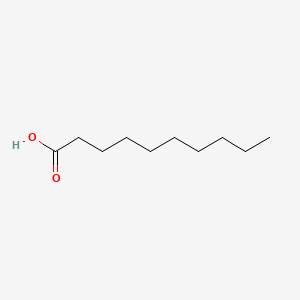
|
Decanoic acid |
Decanoic acid is a lipid of Fatty Acyls (FA) class. Decanoic acid is associated with abnormalities such as Hashimoto Disease, Perisylvian syndrome, Parasitic Diseases, Acute myocardial infarction and Myocardial Infarction. The involved functions are known as Cell Differentiation process, Inflammation, Process, Subtraction process and Pressure- physical agent. Decanoic acid often locates in Epithelium, Tissue membrane, Body tissue, Membrane and Organelles. The associated genes with Decanoic acid are Genome, FATE1 gene, HTR3A wt Allele, FFAR1 gene and O3FAR1 gene. The related lipids are Membrane Lipids, Fatty Acids, Micelles, Stearic acid and rac-glycerol 1-monodecanoate. |
1677 |

|
Gibberellin A3 |
Gibberellin a3 is a lipid of Prenol Lipids (PR) class. The involved functions are known as Germination, ethylene biosynthetic process and cyclin catabolic process. The associated genes with Gibberellin A3 are IPP gene and ARF6 gene. The related lipids are brassinolide. |
1728 |

|
emodin |
emodin is a lipid of Polyketides (PK) class. Emodin is associated with abnormalities such as Infection, Conjunctivitis, Vernal, Stevens-Johnson Syndrome, Conjunctival scar and Allergic Conjunctivitis. The involved functions are known as signaling cascade, Metabolic Inhibition, Cell Death, Phosphorylation and JNK Pathway. Emodin often locates in Membrane, Protoplasm, Mitochondria, Cytoplasmic matrix and soluble. The associated genes with emodin are cytochrome c'', UTS2 gene, TK Gene, Gene Clusters and CFC1 gene. The related lipids are Phosphatidylserines, Promega, Sphingolipids, Membrane Lipids and Palmitates. The related experimental models are Mouse Model and Transgenic Model. |
1742 |
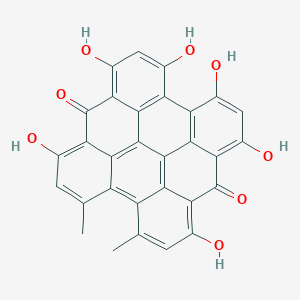
|
hypericin |
hypericin is a lipid of Polyketides (PK) class. Hypericin is associated with abnormalities such as Dermatitis, Phototoxic, Dehydration, Photosensitization, Morphologically altered structure and Myocardial Infarction. The involved functions are known as Cell Cycle Checkpoints, Apoptosis, Acetylation, Cell Survival and Caspase Activation. Hypericin often locates in insoluble fraction, Cytoplasmic matrix, Protoplasm, Tissue membrane and Cytoplasm. The associated genes with hypericin are CDC37 gene, HSPA8 gene, RAF1 gene, cyclin H and FK228. The related lipids are Phosphatidylserines. |
1752 |

|
(e,e,e,e)-squalene |
(e,e,e,e)-squalene is a lipid of Fatty Acyls (FA) class. (e,e,e,e)-squalene is associated with abnormalities such as Hypercholesterolemia and Cataract. The involved functions are known as Process, metaplastic cell transformation, Protein Overexpression, Anabolism and Biosynthetic Pathways. (e,e,e,e)-squalene often locates in Membrane, Protoplasm, Plasma membrane, Tissue membrane and Back. The associated genes with (e,e,e,e)-squalene are Genome, IMPACT gene, GAPDH gene, GTF2I gene and Chromatin. The related lipids are Membrane Lipids, cycloartenol, Sterols, Fatty Acids and Nonesterified Fatty Acids. |
1766 |
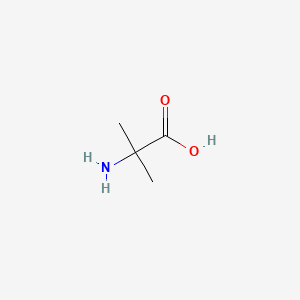
|
2-amino-isobutyric acid |
2-amino-isobutyric acid is a lipid of Fatty Acyls (FA) class. |
1792 |
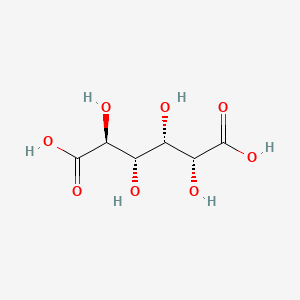
|
Glucaric acid |
Glucaric acid is a lipid of Fatty Acyls (FA) class. Glucaric acid is associated with abnormalities such as Consumption-archaic term for TB and furuncle. The involved functions are known as Oxidation, Mutation, Process, Cell Growth and Anabolism. Glucaric acid often locates in BL21, Clone and host. The associated genes with Glucaric acid are MIOX gene, ISYNA1 gene, Genome and Candidate Disease Gene. The related experimental models are Knock-out. |
1814 |
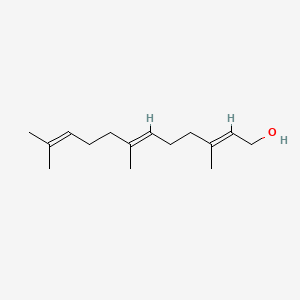
|
2E,6E-farnesol |
2e,6e-farnesol is a lipid of Prenol Lipids (PR) class. 2e,6e-farnesol is associated with abnormalities such as Granulomatous Disease, Chronic, pathologic fistula and Cavitation. The involved functions are known as Regulation, Metabolic Inhibition, cholesterol biosynthetic process, Process and Transcription, Genetic. 2e,6e-farnesol often locates in Plasma membrane, Cytoplasmic matrix, cornified envelope, Epidermis and peroxisome. The associated genes with 2E,6E-farnesol are RAB3A gene, FOSL1 gene, CASP8AP2 gene, RCC1 gene and GALE gene. The related lipids are Sterols, Membrane Lipids and Steroids. |
1905 |
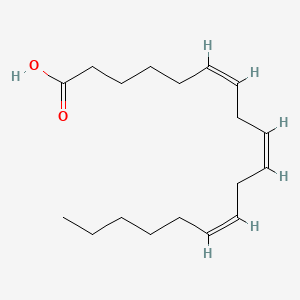
|
gamma-Linolenic acid |
Gamma-linolenic acid is a lipid of Fatty Acyls (FA) class. The involved functions are known as Drug Interactions. Gamma-linolenic acid often locates in Articular system. |
1919 |



































































































